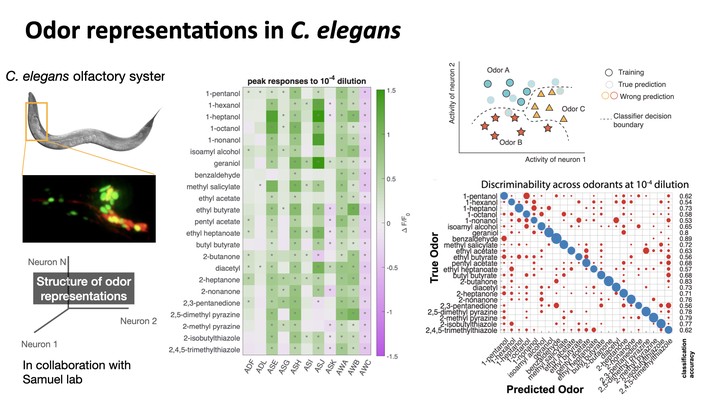Odor representation in C. elegans

Insects and mammalian olfactory systems employ large ensembles of olfactory sensory neurons (OSNs) to detect and distinguish numerous volatile molecules in the environment. Each OSN typically expresses only one type of odor receptor and it responds to different odorants. Each odor elicit a neuronal response patterns across different OSNs, forming a “combinatory code”. In contrast, olfactory circuits in the tiny nematode C. elegans have a compact and distinct cellular organization. There are about 1200 putative chemosensory GPCR receptors, and they are expressed in only 11 pairs of sensory neurons. Although odorant-evoked responses in many chemosensory neurons in C. elegans have been well characterized, how their collective dynamics might represent odorant information as an ensemble remains unexplored.
We used microfluidics and multineuronal imaging to study ensemble level olfactory representations at the sensory periphery of the nematode C. elegans. The collective activity of nematode chemosensory neurons reveals high-dimensional representations of olfactory information across a broad space of odorant molecules. We reveal diverse tuning properties and dose-response curves across chemosensory neurons and across odorants. We describe the unique contribution of each sensory neuron to an ensemble-level code for volatile odorants. We also show how natural stimuli, a set of nematode pheromones, are encoded by the sensory periphery. The integrated activity of the C. elegans chemosensory neurons contains sufficient information to robustly encode the intensity and identity of diverse chemical stimuli.
A. Lin, S. Qin, H. Casademunt, M. Wu, W. Hung, G. Cain, N. Z. Tan, R. Valenzuela, L Lesanpezeshki, C. Pehlevan, V. Venkatachalam, M. Zhen, A. D. T. Samuel, “ Functional imaging and quantification of multi-neuronal olfactory responses in C. elegans”. Science Advances (accepted). doi: 10.1101/2022.05.27.493772.